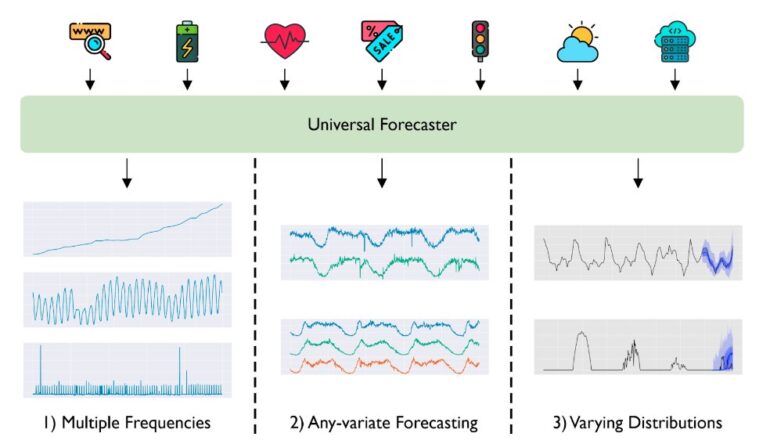- Salesforce AI introduces Moira, a cutting-edge time series forecasting model.
- Moira aims to achieve universal forecasting capabilities across various domains and frequencies.
- Traditional deep learning models are often tailored to specific datasets, leading to inefficiencies.
- Moira addresses limitations by offering a universal approach to forecasting that is adaptable to diverse datasets and frequencies.
- Moira employs novel enhancements to handle the heterogeneity of time series data.
- Through rigorous evaluation, Moira demonstrates superior performance compared to traditional models.
Main AI News:
Salesforce AI’s unveiling of Moira represents a significant leap forward in the realm of time series forecasting, offering a groundbreaking solution to the challenge of achieving universal predictive accuracy across diverse domains and frequencies. The traditional landscape of deep learning models for time series forecasting has long grappled with the inefficiencies stemming from their tailored nature to specific datasets, resulting in substantial computational overhead and resource intensiveness. Addressing these limitations, Moira emerges as a pioneering force, ushering in a new era of universal forecasting frameworks.
At its core, Moira’s innovation lies in its ability to transcend the constraints imposed by conventional models by introducing a universal approach to time series forecasting. Unlike its predecessors, which are confined by fixed contexts and prediction lengths, Moira boasts a dynamic architecture that adapts seamlessly to diverse datasets, frequencies, and variables, all in a zero-shot manner. This adaptability is achieved through a series of groundbreaking enhancements, each designed to tackle a specific challenge in the realm of time series analysis.
Central to Moira’s prowess is its adeptness in handling the heterogeneity inherent in arbitrary time series data. Leveraging novel enhancements to the traditional time series transformer architecture, Moira incorporates multiple input and output projection layers to accommodate changing frequencies, ensuring robust performance across a spectrum of temporal contexts. Furthermore, Moira employs an innovative any-variate attention mechanism to effectively navigate the shifting dimensions of temporal data, thereby enhancing its predictive capabilities.
In addition to its architectural innovations, Moira introduces a novel approach to predictive modeling through the integration of parametric distributions. By combining multiple distributions within a mixture framework, Moira is able to generate flexible predictive distributions, thereby enhancing its adaptability to diverse forecasting tasks.
Through rigorous evaluation in both in-distribution and out-of-distribution settings, Moira has demonstrated its efficacy as a zero-shot forecaster, consistently outperforming traditional models across a range of benchmark datasets. Notably, Moira’s performance surpasses baseline models in in-distribution tests, while maintaining competitive parity with alternative approaches in out-of-distribution scenarios. These results underscore Moira’s reliability and versatility, positioning it as a cornerstone solution for organizations seeking to unlock the full potential of time series forecasting in today’s dynamic business landscape.
Conclusion:
The introduction of Moira by Salesforce AI marks a significant advancement in the field of time series forecasting. By offering a universal approach that transcends the limitations of traditional models, Moira has the potential to revolutionize forecasting capabilities across industries. Its adaptability to diverse datasets and frequencies, coupled with superior performance, positions Moira as a formidable solution in the dynamic market landscape, enabling organizations to make more accurate predictions and informed decisions.

